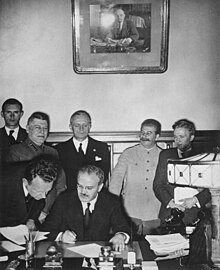German–Soviet Boundary and Friendship Treaty
This article includes a list of general references, but it lacks sufficient corresponding inline citations. (December 2021) |
| German–Soviet Boundary and Friendship Treaty | |
|---|---|
 Soviet Foreign Minister Vyacheslav Molotov signs the German–Soviet Pact in Moscow, 28 September 1939; behind him are Richard Schulze-Kossens (Ribbentrop's adjutant), Boris Shaposhnikov (Red Army Chief of Staff), Joachim von Ribbentrop, Joseph Stalin, Vladimir Pavlov (Soviet translator). Alexey Shkvarzev (Soviet ambassador in Berlin), stands next to Molotov. | |
 Map attached to the German–Soviet Treaty dividing Poland into German and Soviet occupation zones |
The German–Soviet Boundary and Friendship Treaty was a second supplementary protocol
Secret articles

Several
During the western invasion of Poland, the German
Aftermath
The Soviet Union signed a Mutual Assistance Treaty with Estonia on September 28, with Latvia on October 5, and with Lithuania on October 10, 1939. The treaties obliged both parties to respect each other's sovereignty and independence, and allowed the Soviet government to establish military bases in the territory of the three respective Baltic countries.[5] Once established, these Soviet military bases facilitated the full-scale Soviet invasion and occupation of the Baltic countries in June 1940.
According to provisions outlined in the 1939 treaty, Lithuania also acquired about one fifth of the Vilnius Region, including Lithuania's historical capital, Vilnius. The mutual assistance treaties allowed for the 1940 Soviet occupation of the Baltic states and was described by The New York Times as "virtual sacrifice of independence".[6]
References
- ISBN 0191583804. Retrieved 25 April 2015.
For the text of the German–Soviet Frontier Treaty see Degras, Soviet Documents on Foreign Policy, iii. 377.
- ^ Davies 2008, page 30 (ibidem).
- ISBN 978-0-19-820171-7.
- ^ Britannica (2015). "A secret supplementary protocol (signed September 28, 1939)". German-Soviet Nonaggression Pact. Encyclopædia Britannica. Retrieved 25 April 2015.
- ^ Hiden & Salmon (1994). p. 110.
- ^ Gedye, G.E.R. (1939-10-03). "Latvia Gets Delay on Moscow Terms; Lithuania Summoned as Finland Awaits Call to Round Out Baltic 'Peace Bloc'". The New York Times: 1, 6.
- Eidintas, Alfonsas; Vytautas Žalys; Alfred Erich Senn (September 1999). Ed. Edvardas Tuskenis (ed.). Lithuania in European Politics: The Years of the First Republic, 1918–1940 (Paperback ed.). New York: St. Martin's Press. p. 170. ISBN 0-312-22458-3.
External links
 Media related to German–Soviet Boundary and Friendship Treaty at Wikimedia Commons
Media related to German–Soviet Boundary and Friendship Treaty at Wikimedia Commons Works related to German–Soviet Boundary and Friendship Treaty 28 September 1939 at Wikisource
Works related to German–Soviet Boundary and Friendship Treaty 28 September 1939 at Wikisource
